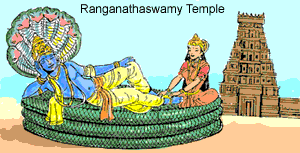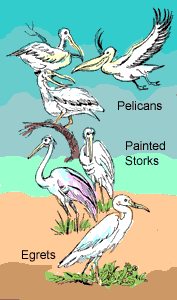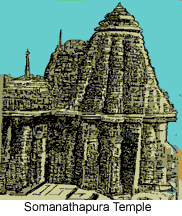
Dimdima
Online Children's Magazine from India

Dimdima
Online Children's Magazine from India

The Ranganathaswamy temple inside Srirangapatnam fort was probably constructed in stages over a long period of time. The main idol of the reclining Ranganatha is a colossal 4.5 m in length. The serpent with its seven broad hoods looms protectively over the idol. Devotees can obtain darshan only from outside the sanctum. Small images of the sage Gautama and the goddess Kaveri are placed at the feet of Ranganatha.
The suburb of Ganjam, on the eastern end of the island outside the fort was founded by Tipu. It was once famous for its figs and the manufacture of textiles and paper. The Catholic church built by Abbe Dubois, a French missionary, in the 18th century, is its only monument of note.
 Four kilometres away from Srirangapatna, on another small island in the Kaveri, is the well-known Ranganathittu Bird Sanctuary. The skies above Ranganathittu are one great sheet of vivid colour between June and December when the birds arrive for breeding. The island was declared a sanctuary in 1940 and attracts a wide variety of avian visitors, including herons, spoonbills, ibises, kingfishers and open-bill storks. Tourists can view the birds from a raised machan in the centre of the island.
Four kilometres away from Srirangapatna, on another small island in the Kaveri, is the well-known Ranganathittu Bird Sanctuary. The skies above Ranganathittu are one great sheet of vivid colour between June and December when the birds arrive for breeding. The island was declared a sanctuary in 1940 and attracts a wide variety of avian visitors, including herons, spoonbills, ibises, kingfishers and open-bill storks. Tourists can view the birds from a raised machan in the centre of the island.
 Following the course of the Kaveri as it turns south from Srirangapatna, almost 25 km away, is the small village of Somanathapura on the left bank of the river. The temple here is an outstanding example of Hoysala architecture, and is better-preserved than the temples in Halebid and Belur. Built by Somanatha Dandanayaka, a minister under the Hoysala king, Narasimha III in 1258, the Keshava temple is constructed in the unique star-shaped plan followed by all Hoysala temples. The outer wall has a series of sculptures depicting parts of the Ramayana and the Mahabharata, while in the garbhagriha are carved images of various deities, 194 in all. The central shrine is empty. The image of Keshava that was once there is now missing.
Following the course of the Kaveri as it turns south from Srirangapatna, almost 25 km away, is the small village of Somanathapura on the left bank of the river. The temple here is an outstanding example of Hoysala architecture, and is better-preserved than the temples in Halebid and Belur. Built by Somanatha Dandanayaka, a minister under the Hoysala king, Narasimha III in 1258, the Keshava temple is constructed in the unique star-shaped plan followed by all Hoysala temples. The outer wall has a series of sculptures depicting parts of the Ramayana and the Mahabharata, while in the garbhagriha are carved images of various deities, 194 in all. The central shrine is empty. The image of Keshava that was once there is now missing.
Though the actual builders and sculptors of most great Indian temples remain anonymous, at Somanathapura, the wall-panels on the exterior of the temple carry the 'autographs' of the sculptors! A delicately wrought slab also acquaints posterity with the names of those who made grants to the temple. Soma is credited with constructing four other temples here, but the Panchalingeswara and Lakshminarasimha temples are the only two structures besides the Keshava temple, to survive the ravages of time. They are now in a state of ruin. And if something is not done soon by the government to restore and preserve it, the lovely Keshava temple too, may meet the same fate.
Last updated on :11/3/2003
Dimdima is the Sanskrit word for ‘drumbeat’. In olden days, victory in battle was heralded by the beat of drums or any important news to be conveyed to the people used to be accompanied with drumbeats.
Bharatiya Vidya Bhavan
K. M Munshi Marg,
Chowpatty, Mumbai - 400 007
email : editor@dimdima.com
Bharatiya Vidya Bhavan
505, Sane Guruji Marg,
Tardeo, Mumbai - 400 034
email : promo@dimdima.com
Dimdima.com, the Children's Website of Bharatiya Vidya Bhavan launched in 2000 and came out with a Printed version of Dimdima Magazine in 2004. At present the Printed Version have more than 35,000 subscribers from India and Abroad.